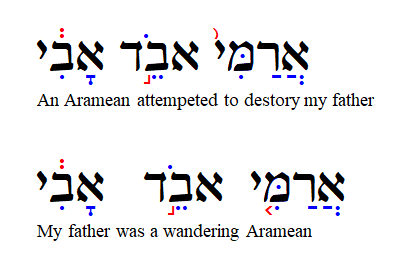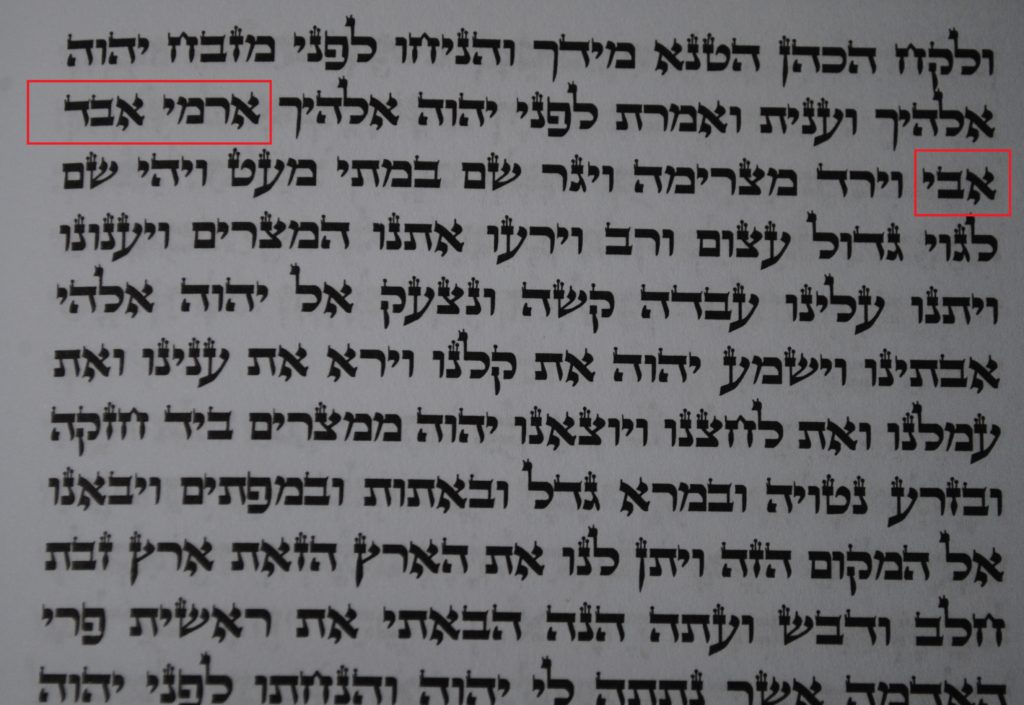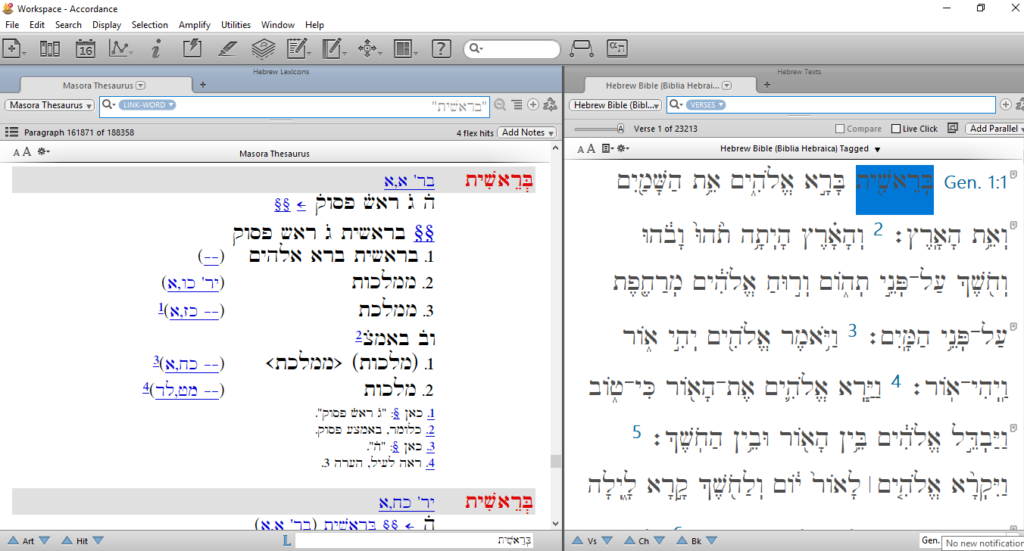The following widely used texts agree with having אֲנוּ
1)The Jerusalem Crown: Keter Yerushalayim (pg. 467)
(2) The Biblia Hebraica Stuttgartensia, (pg 867)
(3)Rabbi M. Breuer’s Tanakh( שנט or pg. 359 )
(3)Meïr Halevi (Letteris) Tanakh (pg. 812)
(4)Norman Henry Snaith’s Tanakh (Pg. 776)
These three popular versions leave אנו unpointed
(1) C.D. Ginsburg Tanakh (pg. 912)
(2) Koren Tanach (pg. 430)
(3) Adi (A. Dotan) Tanakh (pg. 712)
(4) The Stone Edition of the Tanach (pg. 1172)
(5)The JPS Hebrew-English Tanakh (pg. 1115)
TanakhML Project and the online Westminster Leningrad Codex 4.14 have אֲנַ֜חְנוּ in the text with אנו as a subscript. however, both also display other choices. If you click on אֲנַ֜חְנוּ in the TanakhML it will open another page with variants.
Masora
How the accents of the Hebrew Bible can change the meaning?
Does the study of the
Yes, I believe so take Deuteronomy 26:5 for example. Below is an image of the text in Hebrew. Notice that the text of Deuteronomy has been mirrored. The Hebrew consonants’ of both texts colored in black as well as the ‘vowels’ colored in blue are identical. The accents/cantillation marks are colored red. However, to demonstrate how accents can radically change the meaning of the text one accent on the first word (on the right) has been substituted for another:

Now, examine how this same verse appears in a Torah scroll the verse appears neither with accents nor with vowel points. So a reader without these Masoretic notations would have had to decide from him or herself how to interpret this verse:

For more on the on the issue mentioned above check out:
https://www.thetorah.com/article/did-an-aramean-try-to-destroy-our-father
https://www.myjewishlearning.com/article/an-aramean-destroyed-my-father/
The above was originally posted back n 2018 on the Logos forums: https://community.logos.com/forums/p/135738/1008148.aspx#1008148
Here I have made a few minor changes and additions.
1 Kings 17:6 a Masoretic issue
It would seem that most (if not all) translators follow the ‘Ktiv Menuqad’ of the ‘Masoretic’ text when attempting to render 1 kings 17:6 into English. In doing so translators have either knowingly or unwittingly accepted the Masoretes’ interpretation of scripture. The text that lay before the Masoretes was probably the ambiguous

What’s your opinion or take on the above? In the over all context of the narrative how do you think the word under consideration should be rendered and why?
The Masora Thesaurus (part two)
I originally posted the following as a series of replies on the Accordance forums in December of 2015.
The printed BHS only contains the Masora Parva, Masora finalis (and a highly edited form of that). Also. The editors of the BHS put theMasora Magna in a separate volume that is now out of print (although a digital edition of that does exist).
The Masorah Thesaurus has so much more. It has the unedited Masorah Parva, the Masorah Magna of the Leningrad Codex(and other sources, too), as well cross references to other Masoretic list, notations, and texts (as well as more). The Masorah Thesaurus is of course searchable in ways that neither the print edition of the BHS nor the digital edition of Gerard E. Weil’s Massorah Gedolah: Manuscrit B. 19a de Léningrad are.
In a printed edition of the BHS we turn to page one or to Genesis 1:1. Now, we notice the raised circle above בְּרֵאשִׁית . That circle in our printed BHS alerts us to the marginal notes called Masora Parva. To better illustrate what has just been said take a look at the following:
In the photo (or in the BHS) we notice that the fist letter of the note is the fifth letter of the Hebrew Alphabet ה̇. We, also notice that the ה̇is has a small dot over it. When we see a dot over a letter that often tells us that the letter is meant to be read as a number. In this case, we read is as telling us that there are five occurrences of the word בְּרֵאשִׁית in the text of the Tanach/Hebrew Bible.
We, also notice that there are two other Hebrew letters in the note with dots; both ג̇ and ב̇ followed by abbreviations or shorthand notes. ג̇ being the third letter of the alphabet represent 3, and ב̇ being the second letter represents two (2 plus 3 is, of course, five). So, the Masora tells us that בְּרֵאשִׁיתstarts a stanza(ר״פ) three times (ג̇) , and is embedded in a stanza ( מ״פ) two times(ב̇).
This may help us understand the above abbreviations:
(Within, inside) מ = מצעא
(Head, start) רֹ =ראש
(verse/Stanza) פ = פסוקֹ, פסֹ, פסוֹ
Sometimes (or at least I have seen some use) קֹ in place of פסוקֹ
However, since the Masora Parva is brief it does not list those occurrences mentioned above. Before the advent of the Masorah Thesaurus that we would need to run a quick Accordance search, check out a paper concordance, or wade through Masoretic lists to find all of the occurrences mention in the BHS’ Masora Parva.
The Masora Magna Register at the bottom of the printed BHS, however, does indicate where we can (or could in past time) quickly locate the list in Weil’s Massorah Gedolah.
Unfortunately, the Massorah Gedolah is out of print, but as mention, before there is a digital version of it in another software platform. Before I got access to the Masorah Thesaurus module I, will admit, I used to use the digital version of Weil’s Massorah Gedolah a fair bit and it still has its place. However, the Masorah Thesaurus module offers much more than what Weil’s Massorah Gedolah does.
Now, turn to Genesis 43:8 in a printed edition of the BHS (page 71). Let’s look at a rather famous example:
וַיֹּ֨אמֶר יְהוּדָ֜ה אֶל־יִשְׂרָאֵ֣ל אָבִ֗יו שִׁלְחָ֥ה הַנַּ֛עַר אִתִּ֖י וְנָק֣וּמָה וְנֵלֵ֑כָה וְנִֽחְיֶה֙ וְלֹ֣א נָמ֔וּת גַּם־אֲנַ֥חְנוּ גַם־אַתָּ֖הגַּם־טַפֵּֽנוּ׃
Take a look at the Masora Parva note for Genesis 43:8 : י̇ב̇ פסוק̇ גם גם גם
י̇ב̇ = 12
Verses =פסוק̇
גם גם גם = a construction/string גם
The meaning = There are 12 verses in the Tanach where גם occurs three times.
The Mm register for Genesis 43:8 only has Mm index numbers for the following words:
שִׁלְחָה= Mm index number 2915
וְנָקוּמָה = Mm Index number 3078
In other words neither the BHS nor it’s companion volume Weil’s Masorah Gedolah can help you in finding the list or references for the 12 occurrences of the גם גם גם construction.
Also, in this case, a paper concordance will be of little help since
גם appears something like 769 times in the Tanach/Hebrew Bible.
Click Searching on גם will similarly not help you much.
(However, Accordance’s construction search can find examples of the structure and depending on how many intervening word you selected between each of the גם your results will vary).
However, Since we have the Masorah Thesaurus we can easily find everything the Masora Parva note of the BHS was alluding to:
(1) Open the Masorah Thesaurus
(2) Open the Table contents
(3) Type in גם and search
(4) Now, we will find the information we wanted to know at:
Paragraph 43839 of 188291
Paragraph 43844 of 188291
Paragraph 43850 of 188291
As we can see there simply isn’t enough space in the printed/paper BHS to provide that type of detailed information for every MasorParvava note. This one reason (there are many more) why the Masorah Thesaurus is indispensable for Masoretic studies.
The Masorah Thesaurus
Yet, another reason to get excited about Accordance for Windows and the original Mac OS version as well! Accordance has just released the first part of the Masora Thesaurus. When completed this encyclopedic like volume will contain the complete text of the Masorah Gedolah, Masorah Ketanah, and the Masorah Finalis of the oldest complete codex of the Hebrew Bible/Tanakh known as the Leningrad Codex B19a. This work will also include 30 years worth of Aron Dotan’s notes on the Masora. Aron Dotan is chair of the International Organization for Masoretic Studies and editor of the Biblia Hebraica Leningradensia. Now, this begs the question of what is the Masora?
The term Masorah is ordinarily used in modern biblical studies to refer to the body of marginal notes (i.e., Masoretic notes) which are transmitted with the text, either in a manuscript or in a printed edition. However, this is the narrow sense of the word. In its broadest sense, Masorah refers to traditions and rules, passed down in Judaism for generations, which regulate all aspects of the copying and use of Bible manuscripts…
The Masorah can be divided into several subdivisions. The Masorah Parva (Mp) consists of the Masoretic notes in the side margins of manuscripts (cf. BHS). The Masorah Magna (Mm) includes the notes in the upper and lower margins of the manuscripts…
The Masorah Finalis (Mf) refers to the material collected at the end of a particular book, section (e.g., Torah) or manuscript. In manuscripts, the Mf consists of summary lists, such as the number of verses, sedarim, etc., and information of this type is included in BHS at the end of books.
Kelley, Page H., Daniel S. Mynatt, and Timothy G. Crawford. The Masorah of Biblia Hebraica Stuttgartensia: Introduction and Annotated Glossary. Grand Rapids, MI: William B. Eerdmans Publishing Company, 1998.
The Biblia Hebraica Stuttgartensia (BHS) the longtime popular edition of the Hebrew Bible. only contains the Masora Parva, Masora
Enter Accordance Bible Software‘s Marorah Thesaurus database.

The Masorah Thesaurus has so much more than the printed Masora Magna of the BHS. Accordance database has the unedited Masorah Parva, the Masorah Magna of the Leningrad Codex(AND other Manuscritpt, too), as well cross-references to other Masoretic lists, notations, and texts (as well as much more). Accordance digital Masorah Thesaurus database is, of course, searchable in ways that neither the print edition of the BHS nor the standard digital edition of Gerard E. Weil’s Massorah Gedolah: Manuscrit B. 19a de Léningrad are.
So, that we can better appreciate the Masorah Thesaurus let’s first take a quick look at what the printed BHS offers.
In a printed edition of the BHS we turn to page one or to Genesis 1:1. Now, we notice the raised circle above בְּרֵאשִׁית . That circle in our printed BHS alerts us to the marginal notes called Masora Parva. To better illiterate what has just been said take a look at the following screenshot:

In the photo above (or in the BHS) we notice that the f
We, also notice that there are two other Hebrew letters in the note with dots; both ג̇ and ב̇ followed by abbreviations or short hand notes. ג̇ being the third letter of the alphabet represent 3, and ב̇ being the second letter represents two (2 plus 3 is of course five). So, the Masora tells us that בְּרֵאשִׁית starts a stanza(ר״פ) three times (ג̇) , and is embedded in a stanza ( מ״פ) two times(ב̇).
This may help us understand the above abbreviations:
(Within, inside) מ = מצעא
(Head, start) רֹ =ראש
(verse/Stanza) פ = פסוקֹ, פסֹ, פסוֹ
Sometimes (or at least I have seen some use) קֹ in place of פסוקֹ
However, since the Masora

Unfortunately, Weil’s Massorah Gedolah is out of print, but as mention before there is a digital version of it in another software platform for 99.99USD. However as Accordance Bible Software Masora Thesaurus just about the same at 99.09 it is arguable the better deal because it contain so much more value for the buck.
